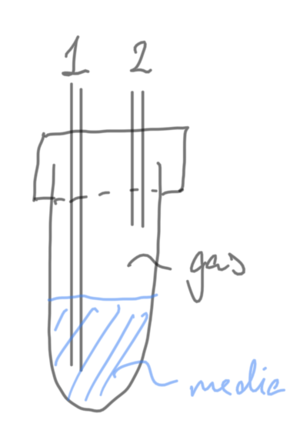Controlling O2 and CO2 level
Contents
Reasons to control O2 and CO2 level
Cells need oxygen for their respiration and CO2 to have the correct pH and carbonate concentration. The pH and carbonate concentration can be controlled by "CO2-independent media" that are media with buffers, i.e. mainly carbonate salts that are balanced to keep the concentrations and pH correct. Over time, however, it is better for the media with cells to be in equilibrium with air with the correct concentration of O2 and CO2.
Ways of achieving correct gas mixtures
There are two basic ways of controlling the gas mixture composition: flow control or pressure-volume control
Flow control
Commercial gas blender measure the flow of each gas and regulate the flow of each input gas to achieve a controlled composition of the output gas. This requires a constant overall flowrate and no changes in the pressure at the inlet or outlet of the device. These gas blenders are therefore well suited to control the gases in volumes that are at atmospheric pressure and in contact with the media (in order to establish diffusive equilibrium) where the cells are.
=== MCQ gas blender Our gas blender can take up to 3 input gases with input pressures < 2 bar (optimal pressure is 1 bar) and output a gas flow at constant flow rate 0-500 ml/min at a constant pressure smaller than the input pressure. The controller settings is done in the computer interface. [Manual for MCQ gas blender]
Pressure - volume control
If we have a container with a manometer (pressure sensor + display), accurate valves and pressurized pure gases we can let in the gases successively to control the final composition. First let's assume that the gases are ideal
and that the gas mixtures are ideal as well
If we desire a CO2 concentration of 5 per cent, (which is much larger than the athmospheric CO2 concentration of ) that means that
and that first one fills up the container with air to the pressure and then continue to fill the container with CO2 until the pressure reaches
Controlling gas mixture before entry into microfluidic network
After detaching cells they should be suspended in new media and transferred to either a syringe or Falcon tube to connect it with the microfluidic circuit. Once it is in a syringe the fluid will get no more regulation of O2 and CO2 since the syringe is closed. The cells use the O2 in the fluid and the respiration increases the CO2 level. If we use a syringe pump there is a limited time before the media is toxic to the cells and the cells become unhappy and die. If we use pressure controlled microfluidics with falcon tubes there is a gas-liquid interface that keep correct O2 and CO2 levels in the media. This is not straight forward, however
Pre-equilibrating the media
The sample holder can be used in two ways: Before connecting to the microfluidic network tube 1 can be connected to a gas blender to bubble the right gas mixture through the gas to equilibrate it.
Correct gas mixture in the control gas
After equilibrating the media tube 1 is connected to the microfluiidic network and tube 2 is connected to the gas pressure controller. If the supply gas of the gas pressure controller has an input gas with the correct gas mixture the media will always have the right concentration of O2, CO2 and pH. This requires an input gas a at high pressure of 2-4 bars. Currently the only way we can achieve this is to use a large container with pre-compressed gas with the right mixture.
Controlling O2, CO2 level and pH in media inside microfluidic network
There are two basic ways to achieve this:
- flowing a gas mixture with the correct composition (including 100% humidity) over a membrane that allows exchange of gas between gas and the media in the microfluidic device. The exchange will then be diffusion controlled and if the distances exceed a few hundred micrometers one needs to estimate the diffusive flow rates to assure that the exchange is fast enough.
- flowing media with controlled composition through the microfluidic network. This flow should be as small as possible to reduce the shear forces on the cells and it must be large enough to assure that the cells do not change the media composition appreciably before it has passed all the cells. We need to find data for the aspiration rate of the cells and calculate this.
